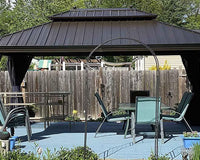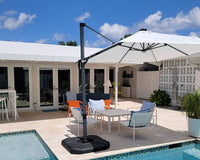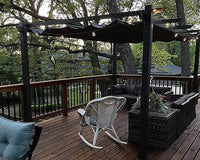When it comes to enhancing your outdoor living space, a pergola can transform a basic patio into a stunning retreat for relaxation and entertainment. While traditional pergolas have graced gardens for centuries with their timeless charm and fixed overhead slats, modern louvered pergolas offer an innovative twist with adjustable panels that provide greater control over sun and rain exposure. As homeowners increasingly seek to maximize their outdoor living areas, choosing between these two options can significantly impact how you enjoy your space throughout the year. This guide will help you navigate the key differences between louvered and traditional pergolas to find the perfect match for your needs.
What Is a Pergola, and Why Do Modern Homes Need One?
Pergolas have come a long way from their ancient origins in Egyptian gardens and Roman courtyards, where they served as elegant support structures for climbing plants. Today, these architectural features have evolved into sophisticated outdoor elements that blend form and function. Modern pergolas create defined spaces within your yard, serving as natural extensions of your home for dining, entertaining, or simply unwinding after a long day.
Whether freestanding or attached to your house, they add architectural interest and vertical dimension to your landscape while providing partial shelter from the elements. With their clean lines and versatile designs, pergolas can transform an ordinary patio into an inviting outdoor room that enhances both your property's value and your quality of life.
Why Do Traditional Pergolas Remain a Popular Choice Today?
Traditional pergolas continue to captivate homeowners with their enduring appeal and versatile design options. Here's what makes them stand out:
Common Materials
- Cedar and redwood for natural beauty and durability
- Vinyl and composite for low maintenance
- Aluminum for modern appeal and longevity
Classic Design Elements
- Parallel rafters creating appealing shadow patterns
- Sturdy support posts with decorative end cuts
- Cross beams for structural integrity
Benefits
- Timeless aesthetic that complements any architectural style
- Lower initial cost compared to modern alternatives
- Excellent support for climbing plants
Limitations
- Fixed overhead structure offers limited weather protection
- Regular maintenance required, especially for wooden structures
- May need periodic resealing or repainting

How Are Louvered Pergolas Revolutionizing Outdoor Living?
Louvered pergolas represent the perfect blend of traditional outdoor structures and modern technology. Here's what makes them unique:
Smart Features
Motorized louvers that rotate 180 degreesSmartphone app control for remote operationRain sensors that automatically close louversLED lighting and heating optionsIntegration with home automation systems
Key Advantages
- Complete control over sun exposure throughout the day
- Protection from unexpected rain showers
- Year-round usability of your outdoor space
- Improved energy efficiency for adjacent indoor areas
- Modern, sophisticated appearance
Notable Considerations
- Higher initial investment compared to traditional pergolas
- Professional installation required
- Potential maintenance needs for mechanical components
- Power source required for operation
- May require occasional software updates or technical support
How Long Will Your Pergola Last, and What Care Does It Need?
The longevity of your pergola largely depends on your choice of materials and how well you maintain it. Cedar and redwood pergolas typically last 20–30 years with proper care, though they require annual staining or sealing to maintain their beauty. Aluminum and vinyl options can extend beyond 30 years with minimal maintenance, making them ideal for busy homeowners in harsh climates.
For louvered systems, the aluminum construction often comes with 10-15 year warranties on mechanical components, while the frame itself can last decades. Regular maintenance is key: traditional wooden pergolas need annual inspections, cleaning, and refinishing, while louvered systems benefit from quarterly mechanism checks, lubrication of moving parts, and occasional cleaning of sensors and controls to ensure smooth operation.

Can You Install a Pergola Yourself, and How Can You Make It Uniquely Yours?
Installation Considerations:
- Traditional pergolas can be DIY-friendly, especially with pre-cut kits
- Louvered systems require professional installation due to electrical and mechanical components
- Both types need proper foundation and permits in most areas
DIY vs Professional:
- Traditional: Weekend project for skilled DIYers
- Louvered: Always requires certified installers
- Expect 1-2 days for traditional, 2-3 days for louvered installation
Customization Options:
1. Traditional Pergolas
- Custom lattice patterns
- Decorative post caps
- Plant hangers and lighting fixtures
- Choice of stains or paint colors
2. Louvered Pergolas
- Integrated lighting systems
- Custom color finishes
- Size and configuration flexibility
- Smart home integration options
What's the True Cost of Owning Different Types of Pergolas?
The investment in your outdoor living space varies significantly between traditional and louvered pergolas. Traditional pergolas typically range from $2,000 to $6,000 for a standard size, with DIY kits starting around $1,500. High-end custom designs can reach $10,000. In contrast, louvered pergolas generally start at $8,000 and can exceed $20,000 for larger spaces with full automation features.
However, the long-term value proposition differs: while traditional pergolas have lower upfront costs, they may require annual maintenance averaging $200-400. Louvered systems, despite higher initial investment, often provide better ROI through extended outdoor living time, increased property value, and lower maintenance costs over their lifespan.

How to Choose the Perfect Pergola for Your Home
When making your final decision, consider these essential factors:
Climate Considerations:
- High rainfall areas benefit from louvered systems' adjustable coverage
- Snowy regions need robust construction for weight-bearing
- Coastal areas require corrosion-resistant materials
- Hot climates may need maximum shade options
Architectural Harmony:
- Contemporary homes pair well with sleek louvered designs
- Traditional homes often match better with classic pergola styles
- Consider your home's existing materials and color palette
- Factor in your neighborhood's overall aesthetic
Lifestyle Needs:
- Frequent entertainers may prefer louvered systems for weather control
- Plant enthusiasts might choose traditional designs for vine growth
- Remote workers seeking outdoor office space benefit from adjustable shade
- Families with children need durability and easy maintenance
Budget Impact:
- Balance initial costs against long-term benefits
- Consider energy savings from improved shade control
- Factor in potential increase in property value
- Think about maintenance costs over time
Final Thoughts
Choosing between a louvered and traditional pergola ultimately comes down to your unique blend of needs, style preferences, and practical considerations. While traditional pergolas offer timeless charm and cost-effective outdoor enhancement at a lower initial investment, louvered systems provide unmatched versatility and weather control with their adjustable features. Consider your local climate, architectural style, lifestyle needs, and budget as you make your decision.




